
Columns

Shameem Akthar explores the link between yoga and the ancient science of marma.
When Bodhidharma, the founder of the Shaolin style of martial arts left India for China, he carried with him the secret wisdom of Kalaripayattu and Marmakalai (the art of marma). He also is said to have carried the herbal healing traditions of southern India. In fact, the ancient science of marma rediscovers itself in all Eastern sciences with various other names that are locally inspired.
The marmas are special points or energy zones of the body. These are said to get blocked by our way of thinking, from anxieties, fears and negativities, collecting emotional and physical toxins. These block the movement of energy, causing pain and, later on, chronic diseases. By palpating these points—through eastern healing practices such as acupressure, acupuncture, reflexology, meditation (focusing on these points or using beej mantras specific to the chakras/psychic centres) and specific oils that may release the blockages—healing may be facilitated.
As mentioned in an earlier column (Feb 2016) of this series, every yoga pose is created with marma points in mind. To undertake yoga practice is to give oneself a massage and treatment in acupressure and reflexology. The points are repeatedly pressed and activated to release their tension and heal. This explains why some poses are complicated and emphasises why the traditional method of yoga must be done without watering it down. Lately, thanks to the efforts of enlightened Ayurvedic scholars like Dr David Frawley and Dr Vasant Lad, more connections and parallels have been drawn between yoga and Ayurveda too, to explain how they complement each other in exploiting the marma map of the body.
In this column, we give you the example of the simple one-legged plough (ekapada halasana) to explain the marma connections to yoga. At the base of the skull, where the scalp meets the neck, are two marma points. Hitting them—with either a kick or a punch in martial arts—can even cause immediate death. This is where the subconscious mind is also said to be reactive. According to Marmakalai, it controls nervous energy and maintains posture. And when the energy flows, it generates positive emotions such as contentment and enthusiasm. In yoga, the plough pose and its variations apply an enormous amount of pressure at these points. Because it is related to the subconscious fear centres, there is always a lot of resistance towards this pose, even in regular or intermediate level practitioners. The pose requires a lot of commitment towards practice because of the intensity of experience it inspires.
YOGIC MOVES
One-legged plough pose (ekapada halasana)
First, master the basic/classic shoulder stand (sarvangasana). To do this, lie on your back, legs stretched out. Beginners may keep legs lightly bent till mastery is achieved. Arms must be stretched out and palms flat on the ground beside the body. Push the palms down, hoist the hips up and then fold arms at elbows to hold hips with palms. Newcomers need to be initiated into this pose with an expert. After a few weeks of practice in this, you may proceed to the one-legged plough. Inhale; exhaling drop your right leg behind the head, towards the ground. Flexible people may be able to reach their toes to the ground. Others can use a prop (a wall behind or stool) on which to place the foot. Inhale; lift the right leg back to the original position. Now repeat for the left leg. Do alternately for either leg, three to five times. With regular practice, you will be able to reach your legs to the ground.
Benefits: This pose activates the marma points at the base of the skull and gives emotional control. Like other inversions, it is anti-ageing, promotes metabolism, and tones the spine and legs.
Sri Ramana Maharishi’s atma vichara
One of the most revered jnana yogis in India is Ramana Maharishi. Most of his wisdom is compiled by his devotees from talks and lectures. Even today, his ashram offers free food and lodging to visitors from around the world, and carries his tradition of simplicity forward. He was marked on the world spiritual map by his devoted disciple Paul Brunton, who wrote A Search in Secret India, exploring the spirituality of India and explaining Ramana Maharishi’s impact on him. This was followed by Somerset Maugham’s Razor’s Edge whose protagonist, it is believed, was based on Brunton. Maugham also had met Sri Ramana.
Sri Ramana’s explanations of the esoteric aspects of the spiritual journey are simple and accessible. There are several compilations of his talks and all are freely available on the website of his ashram Sri Ramanasramam (www.sriramanamaharshi.org) at Tiruvannamalai in Tamil Nadu. He is most famous for the Vedantic query, “Who am I?” This is the most essential spiritual quest; if we learn to keep our mind fixed on this question, the atma vichara (search of the soul), all our other philosophical questions will be answered. His brilliant razor-sharp rationale cuts through spiritual dross.
Here is a classic from the book, Talks with Sri Ramana Maharishi: “Certainly help yourself and that is itself according to God’s will. Every action is prompted by him only. As for prayer for the sake of others, it looks so unselfish on the surface of it. But analyse the feeling and you will detect selfishness there also. You desire others’ happiness so that you may be happy. Or you want the credit for having interceded on others’ behalf. God does not require an intermediary. Mind your business and all will be well.”
Shameem Akthar is a Mumbai-based yoga acharya. If you have any queries for her, mail us or email at contact.us@harmonyindia.org. (Please consult your physician before following the advice given here)
Photo: iStock Featured in Harmony — Celebrate Age Magazine August 2016
you may also like to read
-
Mental workout
Mukul Sharma tells you how to keep those grey cells ticking Everyone will ultimately lose his or her brain….
-
Helpline
Dr Harshbir Rana answers your queries on personal and social issues related to ageing, elder care and intergenerational relationships ….
-
Off the cuff
Raju Mukherji pays tribute to his first hero, Tenzing Norgay, an exemplary mountaineer Darjeeling, 1955. Dr ‘Pahari’ Guha Mazumdar….
-
Yoga RX
Shameem Akthar shows ways to control debilitating ankle pain through regular practice Ankle pain is so common and prevalent….








